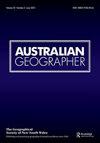Analysing geographic variation in lower urgency emergency department presentations using readily – available administrative boundaries and a novel spatial smoothing technique
IF 2
2区 社会学
Q2 GEOGRAPHY
引用次数: 0
Abstract
ABSTRACT Misallocation of finite healthcare resources can occur when guided by maps that are produced using aggregate-level administrative units. Such maps are affected by the modifiable areal unit problem (MAUP), which describes how patterns may change depending on the particular choice of mapping unit. Smoothing can help avoid this unintended yet detrimental phenomenon. This paper compares the utility of aggregate-level administrative units and smoothing for exploring variation in lower urgency emergency department (ED) presentations across metropolitan Perth, Western Australia. Rates of such presentations were mapped using Australian Bureau of Statistics Statistical Areas Levels 1, 2, and 3 (SA1-3s) and the recently proposed Overlay Aggregation Method (OAM). Resulting maps were compared based on their ability to represent local variation in rates and optimise the targeting and logistical efficiency of geographically targeted resource allocation. SA1-level variation in rates was increasingly obscured by SA2s and SA3s. OAM helped avoid this pitfall, facilitating stable identification of SA1-resolution, high-rate regions while preserving privacy, mitigating the MAUP, and balancing the targeting and logistical efficiency of planned resource allocation to those regions. Routine application of smoothing can help avoid issues undermining maps of lower urgency ED presentations and other health outcomes that are based on aggregate-level administrative units.利用易于获得的行政边界和一种新颖的空间平滑技术,分析低度急诊科表现的地理差异
有限的医疗资源在使用聚合级管理单位生成的地图的指导下可能发生分配不当。这种映射受到可修改面积单元问题(MAUP)的影响,该问题描述了模式如何根据映射单元的特定选择而变化。平滑可以帮助避免这种意想不到的有害现象。本文比较了汇总级行政单位和平滑的效用,以探索低紧急急诊科(ED)的变化在珀斯大都会,西澳大利亚。使用澳大利亚统计局统计区域1、2和3级(SA1-3s)和最近提出的覆盖聚合法(OAM)绘制了此类报告的比率。所得到的地图是根据它们表示当地费率变化的能力和优化地理目标资源分配的目标和后勤效率进行比较的。sa1水平的变化越来越被SA2s和SA3s所掩盖。OAM帮助避免了这一缺陷,促进了sa1分辨率、高速率区域的稳定识别,同时保护了隐私,减轻了MAUP,并平衡了向这些区域分配计划资源的目标和后勤效率。常规应用平滑可以帮助避免问题破坏低紧急ED演示图和其他基于聚合级管理单元的健康结果。
本文章由计算机程序翻译,如有差异,请以英文原文为准。
求助全文
约1分钟内获得全文
求助全文
来源期刊

Australian Geographer
GEOGRAPHY-
CiteScore
4.10
自引率
8.30%
发文量
33
期刊介绍:
Australian Geographer was founded in 1928 and is the nation"s oldest geographical journal. It is a high standard, refereed general geography journal covering all aspects of the discipline, both human and physical. While papers concerning any aspect of geography are considered for publication, the journal focuses primarily on two areas of research: •Australia and its world region, including developments, issues and policies in Australia, the western Pacific, the Indian Ocean, Asia and Antarctica. •Environmental studies, particularly the biophysical environment and human interaction with it.
 求助内容:
求助内容: 应助结果提醒方式:
应助结果提醒方式:


